


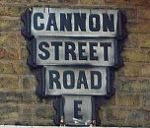 Cannon Street Road and nearby streets
Cannon Street Road and nearby streets
 19th century
19th century There were many tradesmen:
In 1838 M. West, of Cannon
Street Road, won the contract for building All Saints' Church, Mile End
Old Town (in Spicer/Buxton Street - now demolished), with a tender of
£4,095: the final cost was £4,693. The architect was Thomas Larkins
Walker, of Bloomsbury (a pupil of Pugin - though here and elsewhere he
mixed Gothic with Norman styles). The church was consecrated the
following year, with funding from the Church Building Commissioners and
the Metropolitan Church Fund. In 1840 W. Fordham of 37 Cannon Street Road advertised cheap stencilling for landlords and builders [right]. Henry Fitch, at 29½, was a cooper at around this time.
There were many tradesmen:
In 1838 M. West, of Cannon
Street Road, won the contract for building All Saints' Church, Mile End
Old Town (in Spicer/Buxton Street - now demolished), with a tender of
£4,095: the final cost was £4,693. The architect was Thomas Larkins
Walker, of Bloomsbury (a pupil of Pugin - though here and elsewhere he
mixed Gothic with Norman styles). The church was consecrated the
following year, with funding from the Church Building Commissioners and
the Metropolitan Church Fund. In 1840 W. Fordham of 37 Cannon Street Road advertised cheap stencilling for landlords and builders [right]. Henry Fitch, at 29½, was a cooper at around this time.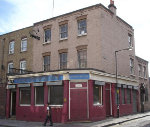 26: Golden Lion
(James Landon) - later no.135 (its landlord in 1921 was Frank Jacobs;
it closed c1989 but remained in use until recently as a private club [right] - and has now re-opened as Maa, a Turkish restaurant).
In 1841 its licensee had been Thomas Lacey, and in 1851 its proprietor
was John Allin, who at the Great Exhibition in that year displayed A group
modelled in wax, representing Sir Robert Peel and Duke of Wellington on
horseback. Designed and modelled by Joseph George Bullock, London
26: Golden Lion
(James Landon) - later no.135 (its landlord in 1921 was Frank Jacobs;
it closed c1989 but remained in use until recently as a private club [right] - and has now re-opened as Maa, a Turkish restaurant).
In 1841 its licensee had been Thomas Lacey, and in 1851 its proprietor
was John Allin, who at the Great Exhibition in that year displayed A group
modelled in wax, representing Sir Robert Peel and Duke of Wellington on
horseback. Designed and modelled by Joseph George Bullock, London 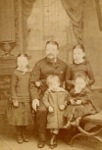 * In the early 1880s William Osborne was the licensee [left in 1882 with his four youngest children Charlotte, Anne, James and Clara]. He prospered, buying houses in Bow, and enjoyed counting out gold sovereigns. His
next son Robert - there were two further boys (one of whom emigrated to
the USA) and a girl - was married in Bow, and seeking to escape the
confines and dirt of the East End took his family to Blackwood in South
Wales, where he became involved in Jerusalem Baptist chapel and the
temperance movement. We're
grateful to Faith Ford for this picture and detailed family
information; more details of this, and their church in Hereford, here.
* In the early 1880s William Osborne was the licensee [left in 1882 with his four youngest children Charlotte, Anne, James and Clara]. He prospered, buying houses in Bow, and enjoyed counting out gold sovereigns. His
next son Robert - there were two further boys (one of whom emigrated to
the USA) and a girl - was married in Bow, and seeking to escape the
confines and dirt of the East End took his family to Blackwood in South
Wales, where he became involved in Jerusalem Baptist chapel and the
temperance movement. We're
grateful to Faith Ford for this picture and detailed family
information; more details of this, and their church in Hereford, here. At no.75 were Turkish baths, extant for a few years from 1865 until
at least 1869. Perhaps they catered for a Jewish clientele who used
them for ritual washing; it's not known whether there were facilities
for women here, though there were at the baths at 7 Commercial Road,
run by Nevill's who were the major providers across London, and mentioned in Terry Pratchett's Dodger (2012), set in Victorian times, and at the Russian vapour baths in Brick Lane - right is a sign from about 1900. See Malcolm Shifrin's comprehensive and fully-illustrated site on Victorian Turkish baths. No.75 seems to have been an unlucky
site: the previous tenant, fruiterer James Hurley, was declared
bankrupt in 1865, as was a later tenant, Gover & Co, leather sellers,
in 1881.
At no.75 were Turkish baths, extant for a few years from 1865 until
at least 1869. Perhaps they catered for a Jewish clientele who used
them for ritual washing; it's not known whether there were facilities
for women here, though there were at the baths at 7 Commercial Road,
run by Nevill's who were the major providers across London, and mentioned in Terry Pratchett's Dodger (2012), set in Victorian times, and at the Russian vapour baths in Brick Lane - right is a sign from about 1900. See Malcolm Shifrin's comprehensive and fully-illustrated site on Victorian Turkish baths. No.75 seems to have been an unlucky
site: the previous tenant, fruiterer James Hurley, was declared
bankrupt in 1865, as was a later tenant, Gover & Co, leather sellers,
in 1881.| CURTAINS AND
SHUTTERS.-— The custom so prevalent of darkening a chamber by
shutters and of surrounding the beds with curtains, especially the
cradles of infants, is very injurious to health, not merely owing to
the causes, (arising from the impurity of air) last specified, but to
the eyesight. When the light is almost entirely excluded, and then the
shutters opened - nearly at once, the pain and violence suffered by,
the eyes would seem naturally to discourage the custom. The use of
curtains is less injurious: but the disuse of them, especially around
the bed or cradle, has often been recommended by physicians. One good
effect of the advice would be, that the eye would gradually become
stronger by being accustomed to the light shaded by the eyelid even
while closed in sleep; and above all other reasons, the increasing
light, especially in a spring or summer morning, would naturally awaken
him, and conduce to the habit of early activity, which is of
incalculable importance. |
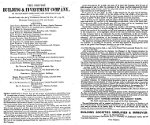 In this same period James Thomas Haunack was listed at this address
as a Land Tax Commissioner for Middlesex; and in 1835 a lawyer Thomas
Humphreys lived here: according to vol.10 of the Legal Observer, Samuel Prentice, of 9 Bedford Street, Mile
End, was articled to him as a clerk, and was admitted as an attorney to the King's Bench (as at the same session was a clerk
articled to the author William Harrison Ainsworth). Five
years later, John T. Hind was resident, and a director of the British
Building and Investment Company, established in 1845, as this advertisement [left] explains, on 'Macarthur's Simple and Improved Plan' with a particular
appeal to thrifty working class people who aspired to home ownership.
By 1855 John Bruce Hind (what relation?) was running an auction and
estate agency office from the same address, and was listed in the Medical Times & Gazette Advertiser
as the local agent of the New Equitable Assurance Company. By 1871, now
from 122 Cannon Street Road [was this a move or a re-numbering?], he was appointed to auction properties, often at
Garraway's, pursuant to Chancery orders, including in 1871 the estate
of John Smith, bone crusher of Whitechapel, in Barkingside and Chadwell
Heath.
In this same period James Thomas Haunack was listed at this address
as a Land Tax Commissioner for Middlesex; and in 1835 a lawyer Thomas
Humphreys lived here: according to vol.10 of the Legal Observer, Samuel Prentice, of 9 Bedford Street, Mile
End, was articled to him as a clerk, and was admitted as an attorney to the King's Bench (as at the same session was a clerk
articled to the author William Harrison Ainsworth). Five
years later, John T. Hind was resident, and a director of the British
Building and Investment Company, established in 1845, as this advertisement [left] explains, on 'Macarthur's Simple and Improved Plan' with a particular
appeal to thrifty working class people who aspired to home ownership.
By 1855 John Bruce Hind (what relation?) was running an auction and
estate agency office from the same address, and was listed in the Medical Times & Gazette Advertiser
as the local agent of the New Equitable Assurance Company. By 1871, now
from 122 Cannon Street Road [was this a move or a re-numbering?], he was appointed to auction properties, often at
Garraway's, pursuant to Chancery orders, including in 1871 the estate
of John Smith, bone crusher of Whitechapel, in Barkingside and Chadwell
Heath.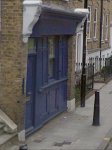 (2) 26 Cannon Street Road
(2) 26 Cannon Street Road Another supplier with premises on the street was Philip Diamond, who was prosecuted in 1907 for possessing and supplying saccharin.
This artificial sweetener, discovered by accident in 1879, is now
widely used, under regulation, as a cheap and potentially 'healthy'
alternative to sugar, but in the early years of its commercialisation its use was
regarded as a fraudulent substitution for a more natural and
nutritionally valuable product. The Pharmaceutical Journal reported thus:
Another supplier with premises on the street was Philip Diamond, who was prosecuted in 1907 for possessing and supplying saccharin.
This artificial sweetener, discovered by accident in 1879, is now
widely used, under regulation, as a cheap and potentially 'healthy'
alternative to sugar, but in the early years of its commercialisation its use was
regarded as a fraudulent substitution for a more natural and
nutritionally valuable product. The Pharmaceutical Journal reported thus:|
On June 13 at Thames Police Court, London, Philip Diamond, 44, described as a mineral water manufacturing agent, of Cannon Street Road, St. George's, was remanded on a charge of concealing a quantity of saccharin with intent to defraud His Majesty's Customs. Mr. Shaw, who prosecuted, said the defendant was a dealer in mineral water articles, and observation had been kept on him by Mr. J. B. Davies, the Preventive inspector, and his staff, for twelve months past ... About nine o'clock on Wednesday night Mr. A. W. Cope, supervisor of the Inland Revenue, entered the defendant's shop, and saw him in a crouching position among some cases which were in a little room. In reply to a question put by Mr. Cope the defendant said I have not got any saccharin at all. Mr Davies then came in, and on a systematic search being made upwards of 2lb. saccharin, marked 500, denoting it was the best quality, was found. Mr Dickinson remanded the defendant, and agreed to accept bail in two sureties of £75 each for his appearance. On June 20, before Mr. Dickinson, Philip Diamond, mineral water manufacturers' agent, of Cannon Street Road, St. George's-in-the-East, surrendered to his bail to further answer a charge of harbouring and concealing a quantity of saccharin. It was stated the Inland Revenue authorities attached considerable importance to the arrest, as the defendant was believed to be one of the principal receivers of saccharin in London, and, as a matter of fact, his shop had been frequented by all those persons lately convicted for smuggling saccharin.It was now stated that during the remand the samples had been examined. Three unopened tins and an opened tin contained saccharin of good quality. Some of the other samples contained sodium salt, and others were granular in appearance. The contents of the paper parcels were mixtures of saccharin and sugar, but the amount of the latter was only 14 per cent and contained a large proportion of Para substance. The samples were analysed by Mr R. Rogers, analyst of the Government laboratory. Mr Dickinson said it was a case for the full penalty and fined the defendant £100 and £15 15s. costs. The money was paid. |
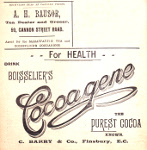

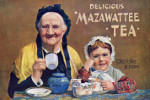
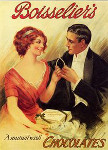 In the 1890s, one of the three or four regular advertisers in the parish magazine had been A.H. Bausor at no.59 - agents for Mazawattee - right - and Boisselier's Cocoagene. Boisselier's were based in Enfield, and in 1895 the local press reported The proprietors of Boisselier’s Cocoagene have
generously offered to hand over to the funds of the Enfield Cottage
Hospital the proceeds of the sale of their Id. boxes of cocoagene,
which they have arranged to sell along the route of the procession of
the Bonfire Boys [a November 5 event]. The generous act, the worthy
object, and the nutritive and lasting properties of the aliment, should
prove a combination strong enough to draw a good many pennies to the
coffers of the Hospital. (Mr Wright collected 7s 5d, Mrs Boisselier 12s 3d and Mr Ayres 16s.)
In the 1890s, one of the three or four regular advertisers in the parish magazine had been A.H. Bausor at no.59 - agents for Mazawattee - right - and Boisselier's Cocoagene. Boisselier's were based in Enfield, and in 1895 the local press reported The proprietors of Boisselier’s Cocoagene have
generously offered to hand over to the funds of the Enfield Cottage
Hospital the proceeds of the sale of their Id. boxes of cocoagene,
which they have arranged to sell along the route of the procession of
the Bonfire Boys [a November 5 event]. The generous act, the worthy
object, and the nutritive and lasting properties of the aliment, should
prove a combination strong enough to draw a good many pennies to the
coffers of the Hospital. (Mr Wright collected 7s 5d, Mrs Boisselier 12s 3d and Mr Ayres 16s.) | 2628. (Major Evans-Gordon) Now with regard to the trade and the traders? —The
characteristic of the foreigner is to deal with, to associate with, and
to herd with people of his own race. Within my knowledge in the past
two years — of my personal knowledge — some four tradesmen once
carrying on prosperous businesses in the Cannon Street Road, St.
George's East, have been ruined by this foreign invasion. They are an
undertaker (Bradford), a grocer (Bausor), an oilman (Steadman), and a
pork butcher (Hasler), all within a stone's throw of each other. Their
former customers, all Britishers, have been compelled to leave the
neighbourhood, and the foreigners will not deal with them .... |
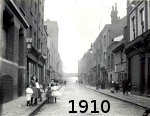

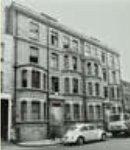

 Left are two views from the Edwardian period, plus Montefiore
House (149-153), social housing for Jewish families - seen in the 1970s when it had become
private dwellings owned by Montefiore Houses Ltd. It was demolished in the 1970s, together with the synagogue at 143-145. (In 1907 an unemployed journeyman tailor,
suffering from depression, hanged himself from a water pipe in the
synagogue.) Right is a 1955 view looking south from under the railway bridge, and the entrance to the church today.
Left are two views from the Edwardian period, plus Montefiore
House (149-153), social housing for Jewish families - seen in the 1970s when it had become
private dwellings owned by Montefiore Houses Ltd. It was demolished in the 1970s, together with the synagogue at 143-145. (In 1907 an unemployed journeyman tailor,
suffering from depression, hanged himself from a water pipe in the
synagogue.) Right is a 1955 view looking south from under the railway bridge, and the entrance to the church today. 
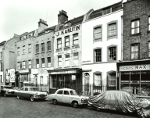
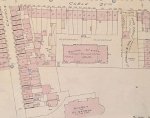
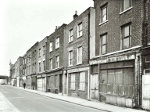
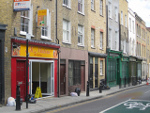 The Georgian row between the church entrance and Cable Street (32-50) is shown left
in Goad's 1899 insurance map; all but those immediately by the church
entrance have survived, but all the shops have become flats, apart from a small restaurant and an Islamic girls' school. It is shown left in 1968 (looking north) and today (looking south). North of the railway, 116-122 is shown right in 1957 and today; the shops and offices from this row have gone, though they occupy most of the rest of the street.
The Georgian row between the church entrance and Cable Street (32-50) is shown left
in Goad's 1899 insurance map; all but those immediately by the church
entrance have survived, but all the shops have become flats, apart from a small restaurant and an Islamic girls' school. It is shown left in 1968 (looking north) and today (looking south). North of the railway, 116-122 is shown right in 1957 and today; the shops and offices from this row have gone, though they occupy most of the rest of the street.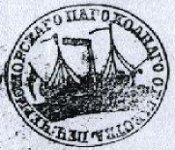
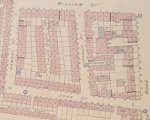 Running west from Cannon Street Road, formerly William Street,
it was renamed in the mid-19th century, probably for the Ponler family, whose details are here.
The adjacent street are shown right on Goad's 1899 insurance map. For a while in the mid-1850s Joseph Platts
and his wife and 8 children
lived at 2 William Street (and later at Clarence Place, Stepney Green).
Born in 1815, from 1837 he was engineer of the Steamboat Company of the
Black Sea and then Chief Consulting Engineer to the Russian Imperial
Admiralty at St Petersburg; a fluent Russian speaker, he was twice
recipient of the Gold Medal with Riband of the Order of St Anne &
Vladimir. The family
left Odessa at the outbreak of the Crimean War in 1855. Letters here relate to his claim for compensation for the destruction
of the steam-powered flour mill which he and his father-in-law John
Tandy ran at Kertch. Eventually he was offered £500 compensation
'without prejudice', for the loss of mill and his services as an
interpreter. He returned to Russia, dying there in 1859 (buried
at Smolensk Cemetery in St Petersburg).
Running west from Cannon Street Road, formerly William Street,
it was renamed in the mid-19th century, probably for the Ponler family, whose details are here.
The adjacent street are shown right on Goad's 1899 insurance map. For a while in the mid-1850s Joseph Platts
and his wife and 8 children
lived at 2 William Street (and later at Clarence Place, Stepney Green).
Born in 1815, from 1837 he was engineer of the Steamboat Company of the
Black Sea and then Chief Consulting Engineer to the Russian Imperial
Admiralty at St Petersburg; a fluent Russian speaker, he was twice
recipient of the Gold Medal with Riband of the Order of St Anne &
Vladimir. The family
left Odessa at the outbreak of the Crimean War in 1855. Letters here relate to his claim for compensation for the destruction
of the steam-powered flour mill which he and his father-in-law John
Tandy ran at Kertch. Eventually he was offered £500 compensation
'without prejudice', for the loss of mill and his services as an
interpreter. He returned to Russia, dying there in 1859 (buried
at Smolensk Cemetery in St Petersburg).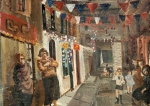 Parallel with William Street to the south, also running west off Cannon Street Road, was John Street, off which was Marmaduke Court to the south (up against the railway viaduct), and Challis [formerly St George's] Court to the north, also accessed from William Street; left is a watercolour by Rose Henriques of bunting for the coronation of George VI in 1937 in this court. Marmaduke Place was off Langdale Street. Another court ran between Samuel and Grove Streets.
Parallel with William Street to the south, also running west off Cannon Street Road, was John Street, off which was Marmaduke Court to the south (up against the railway viaduct), and Challis [formerly St George's] Court to the north, also accessed from William Street; left is a watercolour by Rose Henriques of bunting for the coronation of George VI in 1937 in this court. Marmaduke Place was off Langdale Street. Another court ran between Samuel and Grove Streets.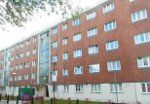
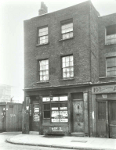 In recent years this area has been entirely rebuilt; it includes
housing by Hunt Thompson Associates which won a North East Thames
Architectural Society award in 1986. The Bangladeshi Youth Movement
(BYM) has its offices in the street, and organises a variety of local activities. Welstead House [right] is on Cannon Street Road at the junction with Ponler Street - on the site which included no.101 [right in 1952].
In recent years this area has been entirely rebuilt; it includes
housing by Hunt Thompson Associates which won a North East Thames
Architectural Society award in 1986. The Bangladeshi Youth Movement
(BYM) has its offices in the street, and organises a variety of local activities. Welstead House [right] is on Cannon Street Road at the junction with Ponler Street - on the site which included no.101 [right in 1952].| Physical Deformities Sir,—The writer would crave the indulgence by your insertion of these few thoughts in your valuable journal, upon a subject which has been entirely overlooked both by the philanthropist and the benevolent portion of the public. I allude to those wretchedly-deformed objects that are allowed to prowl our streets, exhibiting their naked deformities for the purpose of enlisting our sympathies; and when I reflect that they are forced to adopt this expedient by their utter inability to secure a livelihood for themselves, and the fact that amid all the splendid institutions for the relief of suffering humanity, there are none found that would embrace the objects I have alluded to; and how many there are whose friends would shrink from adopting such degraded means and would rather yield to the biting pangs of poverty than submit to such exposures,—and I am an eye witness to many such cases, which have come under my notice in my daily walks among men, and suggested to me what an incalculable amount of misery and sorrow might be alleviated where an institution of the kind existed,—I feel confident that if the press and some influential nobleman and the wealthy of our land would take the subject in hand, they would secure the warmest support of the ladies, who, I am proud to say, are never behind in such laudable works of charity as these. With much respect, I remain your humble servant, W.B.B. Marman-street, Commercial-road East. |
| An Acte for the Mayntenance of Artyllarie and debarringe of unlawful Games (33 Henry 8, C.9) was passed at the instigation of bowyers, fletchers,
stringers and arrowhead makers concerned about the decline of archery,
despite previous statutes aimed at its encouragement, because many
subtill and inventatyve and craftye persons ... have dayly found and
dayly finde many and sondrie new and craftye games and players ...
kepinge houses, playes and allyes for the maynenacne thereof. The first part required all men under 60, not being lame or decrepit (except 'spiritual persons', and judges and justices), to practise long-bow shooting and keep bows and arrows at home. Fathers were to teach their sons to shoot, keeping a bow and two shafts for every boy aged 7-17. This part of the Act was repealed in the 19th century. The next part dealt with unlawful games and their regulation. No-one was to keep for gain, hiring or a living any common house, alley or place of bowling, coyting [quoiting], colysh, cups, half bowl, tennis, dicing-table, or carding, or any other manner of game prohibited by any statute heretofore made, or any unlawful game hereafter to be invented. [C.T. Onions Shakespeare's England, vol II pages 459-68, describes these banned games in detail.] No artificer, husbandman, apprentice, journeyman, labourer, or serving-man was to play at tables, tennis, dice, cards, bowls, of any other unlawful game, out of Christmas, under pain of twenty shillings for every such offence. At Christmas they were only to play in the houses or in presence of their masters. There were two provisos, characteristic of the age: masters could license their servants to play at cards, dice, or tables, with them, or with any other gentleman in their master's house or presence; and noblemen, and those with an annual income of £100, could license their servants or family to play within the precinct of their houses, gardens, or orchards, at cards, dice, tables, bowls, or tennis. But sections 8 & 9, giving powers to raid and prescribing penalties, remained unrepealed. The penalty for keeping a house was 40s., and for 'using or haunting' such houses, and 'playing' in them, 6s.8d. Officials were authorised to raid suspect houses and make arrests, keeping them in prison until they gave sureties not to re-offend. Weekly, or at least monthly, re-searches were required, with a 40s. penalty for breach. |

 Left are the flats in Umberston Street (forming part of the Berner estate), newly-built in 1955, and today.
Left are the flats in Umberston Street (forming part of the Berner estate), newly-built in 1955, and today.
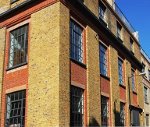
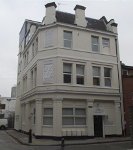
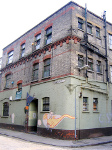 Rampart Street
Rampart StreetBack to History